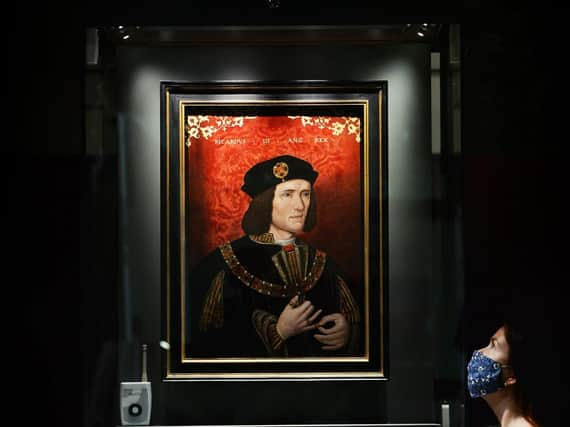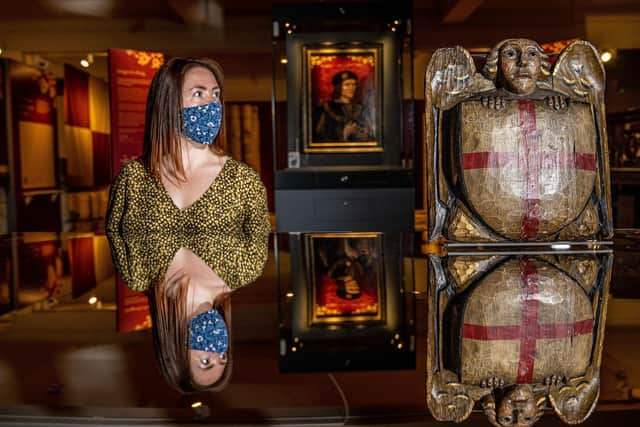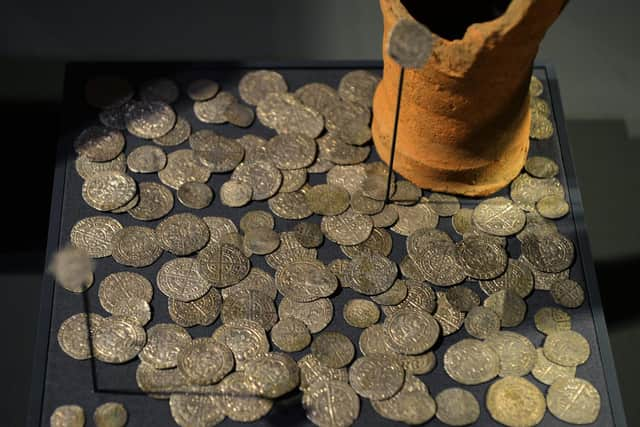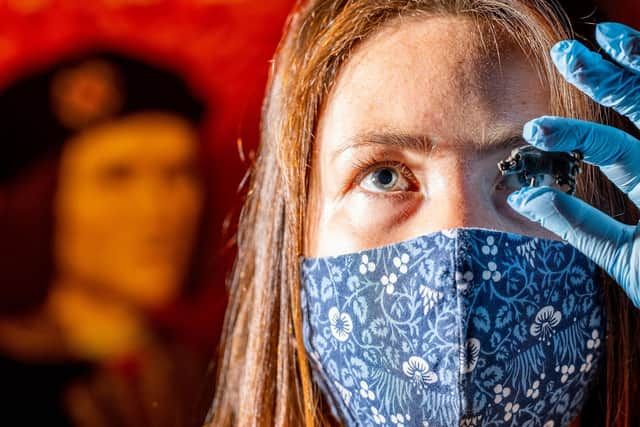Richard III and the story of his 'coming home' exhibition at the Yorkshire Museum


Half a century later, the friary was dissolved, and the church demolished. Richard was left to lie in obscurity under what eventually became a car park, his last resting place marked by oil drips and shopping trips until his remains were sensationally discovered in 2012.
A tussle followed between Leicester and York over where Richard should be reinterred, but against strong claims made by York Minster, Leicester Cathedral won that argument.
Advertisement
Hide AdAdvertisement
Hide AdNow he has come ‘home’ to York. A famous 16th century portrait of Richard III, on loan from the National Portrait Gallery, went on show earlier this month at the Yorkshire Museum, the centrepiece in an exhibition about his reign and life. It’s the first time the museum has been open since the pandemic struck in March last year.


As part of the Coming Home project, iconic portraits are on loan from across the UK. Never seen in Yorkshire before, the portrait of Richard is displayed alongside the Middleham Jewel, the Ryther Hoard and the Stillingfleet boar badge.
Sarah Rees Jones, Professor of Medieval History at the University of York, points to Richard III’s strong links to the city. Before he became king, as the younger brother of King Edward IV, Richard was charged with representing the king in the North.
“He did this with gusto, making sure to win over the leading citizens of York to his cause and ensuring that ‘Ricardians’ filled the main positions of power in the city. Had he survived as king he may have again made York an important base for his household.”
Advertisement
Hide AdAdvertisement
Hide AdProfessor Michael Dobson, of the University of Birmingham, admits his part of the world did Richard few favours.


“Killed in the Midlands in 1485, and dug up in the Midlands in 2013, and in the meantime posthumously defamed by the Midlands’ greatest writer, William Shakespeare. Which should we remember, the real king of history, or the marvellous theatrical villain of Shakespeare’s play?
“Given how charismatically awful Shakespeare made his deformed anti-hero, it is sad to have to admit how comparatively nice the real Richard III really was.”
Lucy Creighton, curator of archaeology at the Yorkshire Museum, observes that although his reign only lasted three years, Richard III endures in the public imagination.
Advertisement
Hide AdAdvertisement
Hide Ad“This is both because of his deeds during his life and his portrayal after his death. Shakespeare is one of several Tudor propagandists who portray Richard in an increasingly negative way following his death, to legitimise the new reign of Henry Tudor.”


Chronicles written during Richard’s lifetime were altered to make physical descriptions more negative, culminating in Shakespeare’s hunchback.
“Interestingly, the exhibition touches on and explores Richard’s disability which has become part of his character,” says Lucy.
“This aspect of his physicality, his scoliosis, curvature of the spine, for many years was believed by some to be a myth made up by propagandists.”
Advertisement
Hide AdAdvertisement
Hide AdAfter his remains were recovered, osteo-archaeological analysis confirmed that Richard had suffered from curvature of the spine. In the portrait, one shoulder is more raised, a subtle sign of this disability.
The portrait, by an unknown artist, was painted in the 16th-century, probably copied from an earlier work that no longer exists. It is on an oak panel and scientific analysis using dendrochronology shows the tree in question was felled in 1577.
“We know that it was also painted shortly after 1577,” says Lucy. “This would have been one of a set of royal portraits, a decorative scheme for a wood-panelled room.”
Richard planned to be buried in York Minster, Lucy believes.
Advertisement
Hide AdAdvertisement
Hide Ad“We know this because after he became king in 1483, he started planning for the establishment of a large chapel of priests at York Minster, and this would have housed 100 priests to pray for the souls of Richard and the royal family. Such an investment does suggest that he wanted to be buried here.”
Many of the star objects in the exhibition were found by metal detectorists. Two high-profile examples are the Middleham Jewel discovered in 1985 and the York boar badge found in 2010 at Stillingfleet.
The Middleham Jewel is said to be the finest example of medieval gold work in England. It dates back to the late 15th century and is a spectacular etched gold ornament with a sapphire at its middle, a repurposed bead.
“It’s not just a bit of bling, it’s an object steeped with religious, symbolic and medical purposes,” says Lucy. “It’s a hollow reliquary pendant, so the back can be taken off and inside there would have sat a holy relic.”
Advertisement
Hide AdAdvertisement
Hide AdRichard chose the white boar as his emblem, and the York Boar Badge would have been worn by a prominent follower.
“It’s silver and gilded and it’s a ferocious beast with its snarling mouth and its rippling mane of hair, there’s a lot of dynamism to this object,” says Lucy. “And quite prominent private parts as well, again it’s all about strength. It’s likely that this was made for a high-ranking follower of Richard.”
These and other treasured objects will help explore the county Richard would have called home. Starting with the Wars of the Roses, the exhibition focuses on the Battle of Towton, on Palm Sunday in 1461, the bloodiest battle fought on English soil.
Contemporary records accounted for around 30,000 deaths, although modern estimates put the figure at 10,000. A tall skeleton on loan from the Towton Battlefield Trust acts as a potent symbol for those who lost their lives. It was discovered by archaeologists in a mass grave in 1996.
Advertisement
Hide AdAdvertisement
Hide Ad“Many skeletons had severe blows to their heads but a lack of wounds to their forearms, suggesting they were bound and were captives from the losing side,” says Lucy.
Middleham Castle is explored as a family home, as Richard lived there with his wife Anne Neville and young son, Edward. The exhibition also looks at what York was like in the late 15th century.
“That was a century of contrasts, major building projects like the Minster and local parish churches being started. We became very prosperous but throughout that century the importance of York as England’s second city starts to wane as London becomes more dominant, and trade moves out of York and the population starts to decrease.”
Other objects include the Fulford Ring, a beautiful gold finger ring set with rubies and emeralds, dating to the time Richard would have been in York. “This is to add a bit of colour to the city that Richard would have visited and called home,” says Lucy.
Advertisement
Hide AdAdvertisement
Hide AdA Tudor oak panel from the Percy Inn on Walmgate, once owned by the Percy family, displays a portrait of Henry Percy, whose failure to commit forces helped lead to Richard’s death at Bosworth. Percy ended up working for Henry and became Lord Lieutenant of Yorkshire, later dying during a revolt near his manor in Topcliffe.
Another significant find is the Ryther Hoard, one of the largest 15th-century hoards ever found. It contained 817 silver coins hidden in a jar possibly used as a urinal, and thought to have been buried in 1487, during a Yorkist uprising against Henry Tudor.
Lucy arrived in York three years ago from the Museum of London. “I look after and share the archaeology collections here. It’s a huge, varied and incredibly significant collection. We have material dating back to the early Stone Age, the Paleolithic and right up to the post-Medieval period. We have strengths in our Viking, Medieval and Roman collections. We are a fantastic resource for the history of our region.”
As she is from Sheffield, the job was a happy return. “I was thrilled to be coming back to Yorkshire, a little bit of coming home for me as well.”
Richard III: Coming Home, runs at the Yorkshire Museum until October 31. For more details visit www.yorkshiremuseum.org.uk